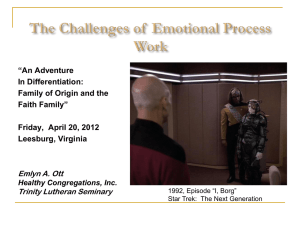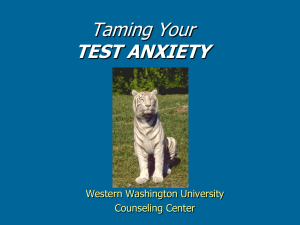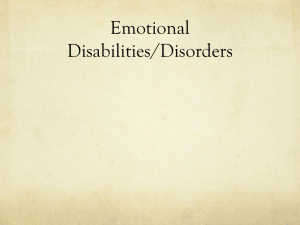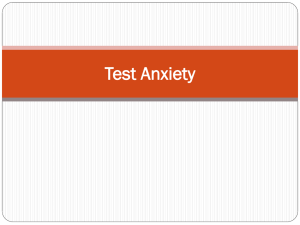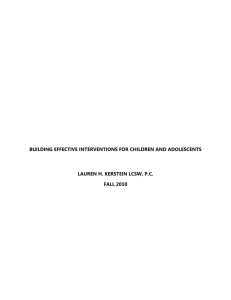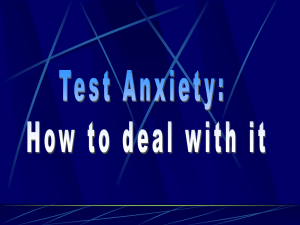February 2015 – What`s a Kid to Do?
advertisement
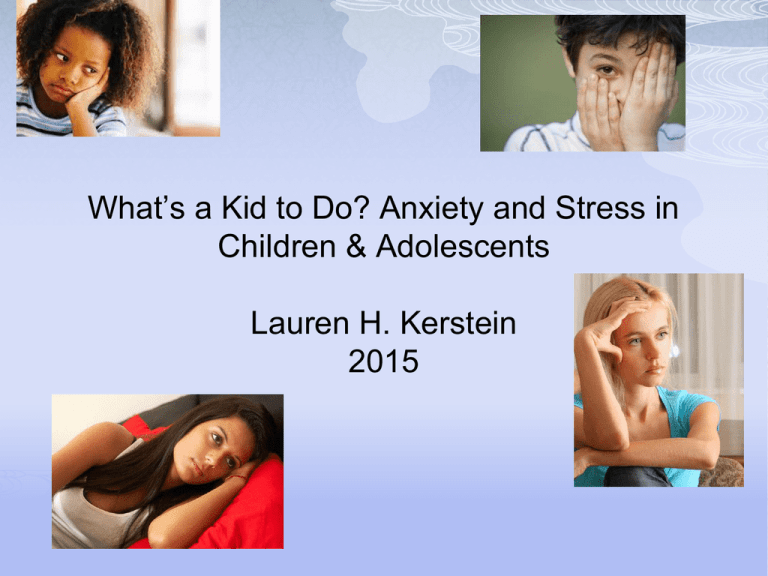
What’s a Kid to Do? Anxiety and Stress in Children & Adolescents Lauren H. Kerstein 2015 With Today’s Presentation, You Will... • Develop an understanding of what anxiety looks like in children and adolescents • Sort out the role that “normal” child development plays in anxiety • Explore ways to increase your child’s capacity for flexible thinking • Fill your toolbox with strategies that will help you help your child manage stress OUR MAIN GOAL IS TO: BUILD ON STRENGTHS Lauren H. Kerstein LCSW, P.C. 2012 Anxiety Looks Different in Children DSM-5 Anxiety Disorders • • • • • • • • • • • Separation Anxiety Disorder (309.21) Selective Mutism (312.23) Specific Phobia (Codes based on phobic stimulus) Social Anxiety Disorder (Social Phobia) (300.23) Panic Disorder (300.01) Agoraphobia (300.22) Generalized Anxiety Disorder (300.02) Substance/ Medication-Induced Anxiety Disorder Anxiety Disorder Due to Another Medical Condition (293.84) Other Specified Anxiety Disorder (300.09) Unspecified Anxiety Disorder (300.00) DSM-5 Obsessive-Compulsive and Related Disorders • • • • • • Obsessive- Compulsive Disorder (300.3) Body Dysmorphic Disorder (300.7) Hoarding Disorder (300.3) Trichotillomania (Hair-Pulling Disorder) (312.39) Excoriation (Skin-Picking Disorder) (698.4) Substance/Medication-Induced Obsessive-Compulsive and Related Disorder) • Obsessive- Compulsive and Related Disorder Due to Another Medical Condition (294.8) • Other Specified Obsessive-Compulsive and Related Disorder (300.3) • Unspecified Obsessive-Compulsive and Related Disorder (300.3) DSM-5 – Trauma and Stressor Related Disorders • • • • • • Reactive Attachment Disorder (313.89) Disinhibited Social Engagement Disorder (313.89) Posttraumatic Stress Disorder (309.81) Acute Stress Disorder (308.3) Adjustment Disorders Other Specified Trauma- and Stressor- Related Disorder (309.89) • Unspecified Trauma – and Stressor- Related Disorder (309.9) The Wright Family Anxiety Triggers • • • • • • • • • • • • Dark Separation Movies Peer/Social Nightmares Tests Deadlines Changes in Season Darkness/ Increased Light End of School Anticipation of a new teacher Anticipation of a special day– holiday, birthday RED FLAGS: Chansky, 2004 • • • • • • • • • • • • • Excessive distress out of proportion to the situation Easily agitated, angry or distressed Repetitive “what if” concerns Won’t respond to logic Headaches, stomachaches Anticipatory anxiety Sleep disruption Perfectionist tendencies– nothing is good enough Overly responsible Unnecessary apologizing Concerned that others are upset with them Avoidance and/or refusal Excessive time spent consoling/ coaxing in daily activities Child Development Child Development and Anxiety • Anxiety is a normal developmental pattern • Typically, anxiety first appears at about 7–9 months, when infants demonstrate stranger anxiety and become upset in the presence of unfamiliar people. (Developmental Milestone: Discriminate between people) • A second developmental milestone occurs at about 12–18 months, when toddlers demonstrate separation anxiety. (Aware parents may not return. Object permanence, object constancy) • Separation anxiety is usually resolved by age 2 http://www.nasponline.org/resources/intonline/anxiety_huberty.pdf Child Development and Anxiety • Up to about age 8 children tend to become anxious about specific, identifiable events, such as animals, the dark, imaginary figures (monsters under their beds), and of larger children and adults. • After about age 8, anxiety-producing events become more abstract and less specific, such as concern about grades, peer reactions, coping with a new school, and having friends. • Adolescents also may worry more about sexual, religious, and moral issues, as well how they compare to others and if they fit in with their peers. Sometimes, these concerns can raise anxiety to high levels. After the Fight or Flight Response… • • • • • Does anxiety decrease? Intensity? Severity? Duration? Frequency? How Do Children and Adolescents Experience Anxiety? • Physical Symptoms • Behavioral Symptoms • Cognitive Symptoms Physical Symptoms Neurological Body Reactions Other Physical Symptoms • • • • • • • • Difficulty breathing Stomachaches Sleep disruption or trouble falling or staying asleep Headaches Fatigue Nausea Dizziness Unidentified illnesses Behavioral Behavioral Symptoms • • • • • • • • • New or increased clinginess Challenges with separation Extreme shyness (that is out of character) Refusal or oppositional behavior Fidgeting Need for repetition, increased predictability, or rituals Increase or emergence of rigidity Unwillingness to try new things or avoidance Shutting down Other Behaviors • • • • • • • Hair twirling Hand wringing Nail biting Shutting down Increased motor activity Repetitive questions Repetitive behavior Cognitive Symptoms • • • • • Thought distortions or patterns Inability to make a decision Perceptions of interactions, the environment and events that are inaccurate or skewed Challenges with concentration Challenges with learning Cognitive Symptoms Perception of Threat (following a trauma) • • • • • • Neurological Physical Emotional Cognitive Social Perspective Sensory State Memory/ Reptilian Brain • • • • • Trauma is stored in State Memory Lower limbic system Not rational– part of emotional brain Processes raw data Fight, flight, freeze/fall asleep Stress State Memory Triggers all previous relevant memories Assumption: This current situation is threatening FEAR DYNAMIC LEADS TO REPETITIVELY NEGATIVE BEHAVIORS If you believed that a particular behavior would ensure your safety, wouldn’t you engage in that behavior? Vicious Cycle FEAR “BEHAVIORAL” RESPONSE PERPETUATION OF BELIEF SYSTEM (IF I DO THIS, I STAY SAFE) MAINTENANCE OF MALADAPTIVE BEHAVIOR ANXIETY in the Classroom or At Home • Many people look at the child’s fear response as “behavior” ■ ■ ■ ■ ■ ■ ■ ■ ■ ■ ■ ■ ■ ■ Irritability Fatigue Frequent Somatic Complaints Decline in Grades Anger Aggression Defiance Dishonesty Refusal Rigid Withdrawal Poor coping skills with everyday stressors Need for reassurance Suicidal ideation Lauren H. Kerstein LCSW, P.C. 2012 A PERSPECTIVE SHIFT - SKILL FILTER DEVELOP A BETTER UNDERSTANDING OF ANXIETY, AND THEN BUILD A TOOLBOX OF STRATEGIES Develop a More Concrete Understanding of Feelings • • • • • • • • What are feelings What do they look like What do they feel like Background Information/ Context Triggers Intensity Decision Making/Control Strategies Lauren H. Kerstein LCSW (2010) 46 SOCIAL/ EMOTIONAL CONTEXT Lauren H. Kerstein LCSW, PC 2013 Kerstein, L. (2008). My Sensory Book: Working Together to Explore Sensory Issues and the Big Feelings They Can Cause: A Workbook for Parents, Professionals, and Children. Shawnee Mission, KS: Autism Asperger Publishing Company. Feeling Intensity and Decision Making Lauren H. Kerstein LCSW (2010) 48 SELF CHECK THERMOMETER 10 Things that Cause Me Stress Relaxation Strategies HIGH STRESS HIGH STRESS MEDIUM STRESS MEDIUM STRESS LOW STRESS LOW STRESS 9 8 6 5 4 3 2 1 Lauren H. Kerstein LCSW, PC 2010 7 Interventions • • Identify anxiety symptoms Make the anxiety concrete ■ ■ ■ ■ ■ Worry bug Lizard Draw it Name it Describe it SPECIFIC INTERVENTIONS • • • • • • • • • • • • • • • • Dialectical Behavior Therapy Cognitive Behavior Therapy Thought Distortions Cognitive Restructuring Wizard/ Lizard Worry Bug/ Fly Swatter Flip it Negative thinking charts Develop an understanding of feelings Develop an understanding of triggers Role Plays Progressive Relaxation Self-monitoring Help the individual recognize strengths Reward system for conquering fears Children’s Automatic Thoughts Scale Lauren H. Kerstein LCSW, P.C. 2011 BREAKING THE CYCLE (STRATEGIES) Trigger Neg Thought Neg Feeling Strategy Lauren H. Kerstein LCSW, PC 2010 Strategies Know your triggers • Reward… Reward… Reward • Model It, Demonstrate It • Giraffes Can’t Dance • Scaredy Squirrel • Flexible Thinking MODEL IT • Rock brain, “brainpoline” • Flexi brain (Michelle Garcia Winner) • You want me to do what? Find Your Brainpoline • • • • • • Switch seats Drive a different way Clay brain versus rock brain Wizard/ Lizard Breakfast for Dinner Change your language/ talk about flexibility/ model it! Problem Solving Grid Problem Feelings Outcome 1 Outcome 3 Solution 2 Lauren H. Kerstein LCSW, PC 2010 Solution 1 Solution 3 Outcome 2 Lauren H. Kerstein LCSW, P.C. OPTIONS AND CONSEQUENCES Situation Feelings Option 2/ Plan Outcome/Consequence Option 3/ Plan Outcome/Consequence Lauren H. Kerstein LCSW, PC 1/2006 as adapted from Myles, Brenda Smith and Diane Adreon. (2001). Asperger Syndrome and Adolescence – Practical Solutions for School Success. Kansas: Asperger Autism Publishing Company. Lauren H. Kerstein LCSW, PC 2010 Option 1/ Plan Outcome/Consequence POWER CARD (Lauren H. Kerstein 2006, Adapted from Brenda Smith Myles and Richard L. Simpson) In order to stay in control of my body in class, keep my voice low and get my work done, I need to: Listen and follow the rules that keep me, other kids, other adults, my mom, dad and teachers happy and safe Keep my body in control - try to think of a solution to solve the problems instead of yelling – stay calm Lauren H. Kerstein LCSW, PC 2010 Use a break ticket when my thoughts begin to race in my head. Experiential Strategies It’s the Smallest Interventions that Make all the Difference • Corrina Corrina Lauren H. Kerstein LCSW, P.C. www.LaurenKerstein.com www.LaurenKerstein.net


